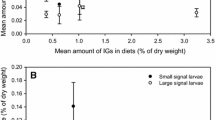Abstract
The lubber grasshopper,Romalea guttata, is a generalist feeding on a broad diet of many herbaceous plant species and has a metathoracic defensive secretion normally containing phenolics and quinones synthesized by the insect. When insects were reared on a restricted diet of wild onion, they sequestered sulfur volatiles from the plant into their defensive secretions. These compounds were not detected by gas chromatography-mass spectroscopy in secretions of insects on an artificial diet or a natural, generalist diet of 26 plants that included wild onion as a component, nor were they present in secretions from field-collected insects. Defensive secretions of insects reared on wild onion were significantly more deterrent, by as much as an order of magnitude, to two species of ant predators than secretions from insects on either of the other two diets, despite a reduction in the concentration of autogenous defensive chemicals in secretions of insects on the onion diet. Sequestration of plant chemicals that increased defensive efficacy occurred when diet breadth was reduced. We suggest that this occurs because under conditions of specialization, plant secondary metabolites are more likely to be ingested and bioaccumulated in sufficient concentrations to have biological activity against predators. What we define as casual bioaccumulation of bioactive plant chemicals following dietary specialization may lead to evolution of sequestered defense syndromes in insects, and this process may not necessarily require specific adaptation to or coevolution with a toxic host plant.
Similar content being viewed by others
References
Boelens, M., de Valois, P.J., Wobben, M.J., andvan der Gen, A. 1971. Volatile flavor compounds from onion.J. Agric. Food Chem. 19:984–991.
Blum, M.S. 1981. Chemical Defenses of Arthropods. Academic Press, New York. 562 pp.
Brodnitz, M.H., Pollock, C.L., andVallon, P.P. 1969. Flavor components of onion oil.J. Agric. Food Chem. 17:760–763.
Brower, L.P. 1984. Chemical defence in butterflies.Symp. R. Entomol. Soc. London 11:109–134.
Brower, L.P., andBrower, J.V.Z. 1964. Birds, butterflies and plant poisons: A study in ecological chemistry.Zoologica 49:137–159.
Carson, J.F., andWong, F.F. 1959. Separation of aliphatic disulfides and trisulfides by gas-liquid partition chromatography.J. Org. Chem. 24:175–179.
Carson, J.F., andWong, F.F. 1961. The volatile flavor components of onions.J. Agric. Food Chem. 9:140–143.
Creighton, W.S. 1950. The ants of North America.Bull. Mus. Comp. Zool. Harv. Univ. 104:8–585.
Dadd, R.H. 1960. The nutritional requirements of locusts 1. Development of synthetic diets and lipid requirements.J. Insect Physiol. 4:319–347.
Duffey, S.S. 1976. Arthropod allomones: chemical effronteries and antagonists,Proc. Intl. Congs. Entomol. 15:323–394.
Duffey, S.S. 1980. Sequestration of plant natural products by insects.Annu. Rev. Entomol. 25:447–477.
Duffey, S.S., andScudder, G.G.E. 1972. Cardiac glycosides in North American Asclepiadaceae, a chemical basis for unpalatability in brightly coloured Hemiptera and Coleoptera.J. Insect Physiol. 18:63–78.
Eisner, T., Hendry, L.B., Peakall, D.B., andMeinwald, J. 1971. 2,5-Dichlorophenol (from ingested herbicide?) in defensive secretion of grasshopper.Science 172:277–278.
Jones, C.G., Hess, T.A., Whitman, D.W., Silk, P.J., andBlum, M.S. 1986. Idiosyncratic variation in chemical defenses between individual generalist grasshoppers.J. Chem. Ecol. 12:749–761.
Jones, C.G., Hess, T.A., Whitman, D.W., Silk, P.J., andBlum, M.S. 1987. Effects of diet breadth on autogenous chemical defense of a generalist grasshopper.J. Chem. Ecol. 13:283–297.
Kevan, D.K.M. 1980.Romalea guttata (Houttuyn), name change for well-known “eastern lubber grasshopper” (Orthoptera: Romaleidae).Entomol. News 91:139–140.
Lofgren, C.F., Banks, W.A., andClancy, B.M. 1975. Biology and control of imported fire ant.Annu. Rev. Entomol. 20:1–30.
Pasteels, J.M., Gregoire, J.-C., andRowell-Rahier, M. 1983a. The chemical ecology of defense in arthropods.Annu. Rev. Entomol. 28:263–289.
Pasteels, J.M., Rowell-Rahier, M., Braekman, J.C., andDupont, A. 1983b. Salicin from host plant as precursor of salicylaldehyde in defensive secretion of chrysomeline larvae.J. Physiol. Entomol. 8:307–314.
Roeske, C.N., Seiber, J.N., Brower, L.P., andMoffitt, C.M. 1976. Milkweed cardenolides and their comparative processing by monarch butterflies (Danaus plexippus L.)Recent Adv. Phytochem. 10:93–167.
Rothschild, M. 1973. Secondary plant substances and warning colouration in insects.Symp. R. Entomol. Soc. London 6:59–83.
Rothschild, M., andAplin, R.T. 1971. Toxins in tiger moths (Arctiidae: Lepidoptera).Pestic. Chem. 3:177–182.
Rothschild, M., andParsons, J. 1962. Pharmacology of the poison gland of the locustPoekilocerus bufonius Klug.Proc. R. Entomol. Soc. London C27:21–22.
Author information
Authors and Affiliations
Rights and permissions
About this article
Cite this article
Jones, C.G., Whitman, D.W., Compton, S.J. et al. Reduction in diet breadth results in sequestration of plant chemicals and increases efficacy of chemical defense in a generalist grasshopper. J Chem Ecol 15, 1811–1822 (1989). https://doi.org/10.1007/BF01012268
Received:
Accepted:
Issue Date:
DOI: https://doi.org/10.1007/BF01012268




